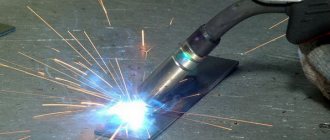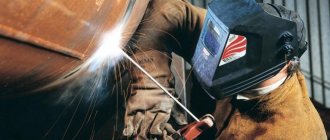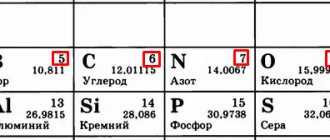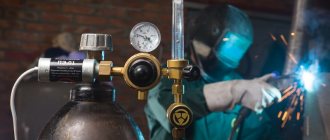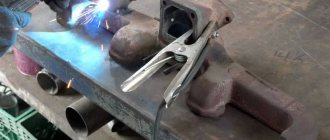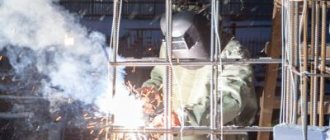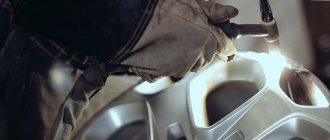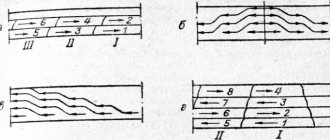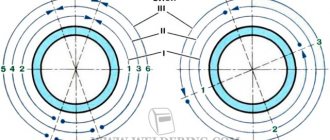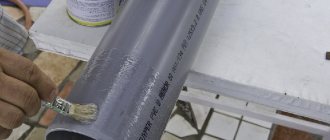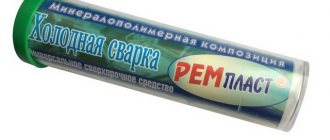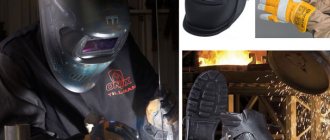Labor protection instructions for electric welders
1.1. Personnel who are at least 18 years old, who have undergone special training, have a certificate for the right to work, including electrical safety group III, and who have no contraindications due to health conditions, are allowed to perform manual electric welding work.
1.2. Electric welders must undergo a mandatory medical examination upon entry to work and periodic medical examinations at least once every 12 months.
1.3. All new hires must undergo induction training at the labor safety service. The results are recorded in the logbook for introductory training on labor protection. After this, the HR department completes the final registration of the newly admitted employee and sends him to the place of work.
1.4. Every new hire must undergo initial training on labor safety in the workplace. All employees undergo repeated training at least twice every 6 months. The briefing is carried out by the head of the department. The results of the briefing are recorded in a journal.
1.5. Daily permission to work is issued in a work order - permission for hot work.
1.6. Upon entry to work and periodically at least once every 12 months, electric welders must undergo a knowledge test on occupational safety issues according to a program approved by the management of the enterprise.
1.7. In the process of performing work, electric welders are required to comply with the requirements of internal labor regulations, work and rest regimes.
1.8. In the course of daily production activities, an electric welder may be exposed to harmful and dangerous production factors:
- increased voltage in the electrical circuit, the closure of which can pass through the worker’s body;
- increased gas and dust levels in the air in the working area;
- increased levels of ultraviolet, visible and infrared radiation;
- increased air temperature in the working area and molten metal.
1.9. While working, electric welders must observe the rules of personal hygiene and wearing special clothing, special shoes, and using other personal protective equipment.
1.10. Overalls and other personal protective equipment are issued in accordance with Standard Industry Standards (see State Register of Inter-Galuzev and Galuzev regulations on the protection of goods).
1.11. Electric welders must not allow deviations from technological standards when carrying out work, know and comply with the requirements of this labor protection instruction, as well as the manufacturer’s instructions for the operation of equipment, accessories, and tools used in the work process.
1.12. The victim or an eyewitness to the accident must immediately notify the work manager of every production-related accident.
The work manager must organize first aid for the victim, transport him to a medical facility, and inform the owner and the labor protection service about this.
To investigate an accident, it is necessary to preserve the situation at the workplace and the condition of the equipment as they were at the time of the incident, unless this threatens the life and health of others and does not lead to an accident.
1.13. Electric welders must know how to provide first aid, how to transport a victim, know the location and contents of the first aid kit, and be able to use the equipment in the first aid kit.
1.14. Persons who violate labor safety instructions are subject to disciplinary and financial liability and an extraordinary test of knowledge about labor protection.
Safety requirements before starting work
2.1. Check the availability and serviceability of personal protective equipment, put them on, fasten the sleeve cuffs of the suit. In this case, the jacket should not be tucked into the trousers, and the trousers should be pulled out over the boots (felt boots).
2.2. Present to the work manager a certificate confirming knowledge of safe work methods.
2.3. Receive a task to perform the work from the manager and a work permit to carry out the work.
2.4. Inspect and prepare the necessary personal protective equipment (when performing ceiling welding - asbestos or canvas oversleeves; when working lying down - warm bedding; when working in wet rooms - dielectric gloves, galoshes or mats; when welding or cutting non-ferrous metals and alloys - a hose gas mask ).
2.5. Inspect and prepare the workplace and approaches to it for compliance with safety requirements:
- remove all unnecessary items without cluttering the aisles;
- check the condition of the floor at the workplace, wipe off wet or slippery floors;
- prepare the tools, equipment and technological equipment necessary to perform the work;
- make sure that the welding equipment is in good condition, that the welding installation is grounded and properly grounded;
- arrange the welding wires so that they are not subject to mechanical damage and high temperature, and do not come into contact with moisture;
- make sure that fire and explosive substances and flammable materials are not stored near the workplace.
The work site, as well as downstream areas, must be freed from flammable materials within a radius of at least 5 m, and from explosive materials and installations - at least 10 m.
2.6.Check the serviceability of a portable lamp with a voltage not exceeding 12V.
2.7. When carrying out welding work in enclosed spaces or on the territory of an operating enterprise, check compliance with fire and explosion safety and ventilation requirements in the work area.
2.8. An electric welder should not start work if the following safety requirements are violated:
- absence or malfunction of the protective shield, welding wires, electrode holder, as well as personal protective equipment;
- absence or malfunction of grounding of the welding transformer housing, secondary winding, welded part and switch casing;
- insufficient lighting of workplaces and approaches to them;
- the absence of fences for workplaces located at a height of 1.3 m or more, and equipped access systems to them in fire and explosive working conditions;
- lack of exhaust ventilation when working in enclosed spaces.
2. 9. Detected violations of safety requirements must be eliminated before work begins, and if it is impossible to do this, the electric welder must report them to the manager.
Safety requirements while performing work
3.1. When performing electric welding work outdoors (during rain or snowfall), a canopy must be installed over the welder’s workplace and the location of the welding machine.
3.2. Electric welding work at height should be performed from scaffolding or scaffolding with guardrails. It is prohibited to carry out work from ladders.
3.3. Welding must be carried out using two wires, one of which is connected to the electrode holder, and the other (reverse) to the part being welded. It is prohibited to use metal structures of buildings, technological equipment, sanitary pipes (water supply, electrical wire, etc.) as the return wire of the grounding network.
3.4. Welding wires must be connected by hot soldering, welding or using couplings with an insulating sheath. Connections must be insulated. Connecting welding wires by twisting is not allowed. Welding wires should be laid so that they cannot be damaged by machines and mechanisms.
3.5. Before welding, the electric welder must make sure that the edges of the product being welded and the adjacent area (20-30 mm) are cleaned of rust, slag, etc.
When cleaning, you must use safety glasses. The parts to be welded must be securely fastened before welding begins.
When cutting structural elements, the electric welder is obliged to take measures against accidental falling of the cut elements.
3.6. During breaks in work, the electric welder is prohibited from leaving an energized electrode holder at the workplace; the welding machine must be turned off and the electrode holder secured to a special stand or suspension.
3.7. Connection and disconnection of welding machines must be carried out by special personnel through an individual switch.
When not to weld
It goes without saying that the welding machine must be grounded. This will prevent electric shock from leaking into the housing. However, this is not enough.
Welding is not allowed in a number of the following cases:
Welding in wet weather increases the risk of electric shock. Moreover, it is impossible for the welding machine to be exposed to the rain, which will inevitably lead to a short circuit with subsequent fire of the wires.
If you have to cook in damp weather, not in the rain, then you need to take into account all the safety issues. First, you should wear dry rubber shoes. Secondly, you should have dry gloves on your hands.
The main thing when welding in wet weather is not to touch the body of the welding machine or the metal parts that are being welded with wet hands. This rule will protect you from electric shock during welding.
Winter is not a hindrance to welding
Welding work has long been no longer considered the privilege of exclusively professionals. Currently, this method of joining metals is actively used in everyday life. At the same time, welding inverters are becoming increasingly popular.
This is understandable: they are light, compact, easy to use and provide excellent seam quality. Most often, welding work is carried out in the warm season. Is it possible to do this at subzero temperatures? Let's try to figure it out.
Welding work in winter
The influence of temperature on the metal welding process
Low temperatures do have an impact on the welding process. The molten metal cools and crystallizes at a faster rate. This means that all dissolved gases do not have time to escape from the weld pool or non-metallic inclusions enter the slag.
This situation can lead to the formation of cracks or pores in the seams. The following statistics are known: when the temperature decreases from +20 °C to -50 °C, the residence time of the weld pool in the liquid state decreases by 10%.
This, in turn, leads to the fact that half of all detected defects relate specifically to non-metallic inclusions.
At low temperatures, heat removal from the welding zone increases. This impairs the penetration of the edges of the joined elements and can lead to the formation of another serious defect - lack of fusion.
An additional danger comes from moisture condensation on the electrodes or metal. Water is a source of hydrogen, which promotes the formation of pores in joints.
In addition, at low temperatures the ductility of steels and the mechanical properties of welds deteriorate.
All the above facts are true, but they are fully manifested at extremely low temperatures (from -40 ° C and below). Household welding rarely requires work in such difficult conditions. As a rule, we are talking about a temperature not lower than -10 °C.
Additionally, it should be taken into account that carbon steels are most often used for domestic purposes. If the thickness of the elements being connected is no more than 16 mm, you can work with them in the usual manner down to a temperature of -30 °C.
For low-alloy steels, this figure for the same thickness is slightly lower and amounts to -15 °C.
The lowest temperature is maintained in outer space. It is -273 °C, but even in such conditions it is possible to carry out welding work. They were first carried out in 1984 by Soviet cosmonauts S. Savitskaya and V. Dzhanibekov. For this purpose, a specially created electron beam welding apparatus was used.
The influence of temperature on the welding inverter
Low temperatures can affect not only metals, but also welding inverters. One of the main enemies of such technology is moisture. Its appearance inside the device can lead to short-circuiting of electronic components and their failure. Low temperatures under certain conditions can contribute to the formation of condensation in welding inverters.
Dew point
In this regard, it is important to remember the concept of dew point. In fact, this is the maximum surface temperature at which moisture appears on it in the form of condensation. In another way, this statement can be rephrased as follows: if the surface is colder than the dew point, then condensation will fall on it.
This value is not constant and directly depends on humidity. The higher it is, the closer the dew point is to the actual temperature. For example, in a shower with 100% humidity, the mirror fogs up at room temperature. The opposite situation occurs in a sealed double-glazed window.
There the humidity is close to zero, so condensation is never observed.
Moisture can condense in a welding inverter only in one case: if it has been left in the cold for some time and then moved into a warmer room. In such a situation, it is strictly forbidden to use it immediately.
The inverter must stand for one and a half to two hours so that its temperature becomes equal to the ambient temperature and the condensation that appears evaporates.
If the device is taken out of a warm room into the cold, condensation cannot form in it and this will not affect the performance of the device in any way.
How to perform welding work in cold weather?
In general, welding work at temperatures not lower than -10 °C can be performed using conventional household inverters without any negative consequences for the quality of the seams, the strength of the joints or the performance of the equipment itself.
In more severe frosts, you should use semi-professional or professional models specifically designed for use at low temperatures. They are equipped with electronic elements that are resistant to cold.
Additionally, several activities should be highlighted that are recommended to be performed when carrying out welding work in winter:
- If possible, avoid intersections of welds and sharp transitions in metal thickness.
- Welding work should begin with seams that give maximum shrinkage (butt seams).
- Minimize the volume of deposited metal.
- During operation, increase the welding current by 10-15% and at the same time reduce the speed of movement of the electrode by approximately the same amount.
- If possible, start and end welding on the lead strips.
- Carefully clean the edges of the elements to be welded.
- Instead of tacks, use, for example, clamps or other similar devices.
- Use types of electrodes that are not prone to pore formation and ensure high ductility of seams: E50A, E46A or E42A with a basic coating. They must be thoroughly calcined before use.
Inverters for welding in winter
The effect of negative temperatures on the welder
Negative temperatures can affect not only metals or equipment, but also directly on welders. Working capacity in such conditions decreases, which means the risk of defects increases. The best way to avoid this situation is to use special winter protective clothing. Welding helmets deserve no less attention.
“Chameleons” are currently the most popular. Their main element is a light filter. It consists of several layers of liquid crystals and polarizing films.
The light filter reacts to the intensity of light radiation and works automatically. It takes no more than 0.001 seconds to darken.
This is quite enough to reliably protect the eyes from the harmful effects of ultraviolet radiation that occurs during welding.
Welding at home. Means of protection
If you purchased a welding machine for welding at home, do not skimp on protective equipment. When welding indoors, do not forget about a properly equipped welding station.
How to protect yourself and the people around you from home welding? Let's try to figure it out in this article.
For those who want to cook in the apartment, it should immediately be noted that the apartment is not an industrial premises and such activities are prohibited in it. Why are we just banned? My property, I do what I want.
What are the dangers of carrying out welding work in an apartment?
- Fire. Still, there are many things and objects that are easily flammable. A fire extinguisher is required.
- They try to cook on the balcony, in the corridor, on the landing - a good idea until practice begins. Try to burn at least one electrode in a closed room without an exhaust hood, and you will understand how stupid the idea is. Even when welding on a balcony with open windows, the smoke dissipates after fifteen minutes, and the smell lasts for several days. In this case, maybe TIG welding can solve the problem with excessive smoke, but if only smoke was a problem.
- Spatters of metal from electrode welding fly in all directions. The welding area must be fenced.
- The welding machine heavily loads the electrical network, when the lights in the neighboring apartments start blinking, problems with the neighbors will begin. It is only possible to weld with electrodes up to 2 mm at currents of 30-50A. If an electric stove is installed in the apartment, welding at higher currents is possible.
The conclusion is clear: if you have just purchased a welding inverter and you are eager to cook with it and test it, you should not do this in an apartment or private house. At a minimum, you will be guaranteed problems with your neighbors, and at a maximum, you are thereby endangering the lives of people and the safety of property.
If you don't have a suitable space, purchase a garage or workshop.
The activity of an electric welder is associated with a certain health risk; this cannot be treated negligently. You must always think through your actions before starting work.
With regard to workwear, there is no point in establishing any strict limits (what material it should be made of - tarpaulin, split wood, other fire-resistant material). Because the intensity of welding at home is not at all the same as it can be in production.
The main requirement for workwear is that it must have a protective function: cover all exposed areas of the body and be made from natural materials, in no case synthetic.
It is also important to know that burns during welding can be obtained not only from splashes and drops of molten metal, but also from ultraviolet radiation emitted by the welding arc. And often the weakest points are:
- Face. It is not always possible to hold the welding shield (if anyone uses it) correctly during assembly and setting of tacks;
- Neck due to an unbuttoned collar;
- Wrists due to insufficient length of mittens or cuffs.
Unfortunately, for most home welders, such burns are commonplace. The need to close comes with bitter experience. If you are not confident that your workwear is protecting you as required, then this uncertainty will be reflected in the welding itself. Protect yourself in a way that does not hinder your movements.
What do experienced welders usually not think about, or what do experienced welders neglect?
- Exhaust or ventilation in the workplace;
- Respiratory protection;
- Hand protection. The use of gloves and mittens during preparatory work, marking, cutting, stripping metal, as well as during its assembly, tack welding, welding of finished structures;
- Eye protection
Ventilation of the workplace
During welding, harmful substances are released, but not all welders pay due attention to this, often becoming very interested in the process.
Therefore, the place in which you plan to cook must be equipped with ventilation or an exhaust hood, because the consequences of inhaling harmful substances may not appear immediately, but after many years.
Everyone should think about what can be done in their particular case. Don’t forget, you need to invest in your health too.
If you work outside in the open air, you will be at the mercy of weather conditions. Working in the rain, as well as after it, with wet metal is strictly prohibited! There is a high risk of electric shock.
If you work outside, but under a canopy, there is no point in thinking about a hood; natural air circulation in this case will be enough. However, if the place where your welding work is carried out is a garage or workshop, then simply opening the door or gate will not save you from harmful smoke.
Installing expensive exhaust equipment is not affordable for everyone, so the most budget-friendly and simplest solution would be to install an exhaust fan in one of the walls of your room.
Such fans will successfully cope with gas pollution in the room and will become reliable assistants in protecting the respiratory system.
Hand protection
Most DIYers don't think twice about what hand protection to use. They take either those that they have in stock, or those that are imposed by the stereotypes of the profession.
Let's figure this out.
The image of a Soviet welder appears before us in all canvas, including mittens. However, we are not only welders. We need to do a variety of work related to marking metal, preparing it for welding, and cutting. You can't do this kind of work with mittens.
You can’t work without protective equipment at all: your hands are susceptible to cuts due to sharp metal edges and burrs, as well as smeared hands from rusty metal or oiled metal, if it’s new, creating discomfort at work. Therefore, gloves are necessary for such work.
These can be cotton or rubber gloves.
The next stage in the work is assembly and tack. Here you need to find a middle ground so that you can work comfortably and at the same time have complete security.
Cotton gloves are not suitable for this, since due to their structure they have the ability to retain splashes and drops of metal that get on the hands, which are released even when using tacks. Mittens and leggings do not provide complete control when placing workpieces.
When using such protective equipment, the accuracy of installation, and sometimes the leggings or mittens themselves, suffer. Therefore, select for assembly something that gives you a feeling of comfort and control over the assembly process.
The best option for assembling and tack are gaiters or gloves made from suede leather, but the main thing is that they are unlined. Or gloves designed for argon workers, they have a lower density, which means the sensitivity of the hands is much higher, which will have a positive effect on the assembly process.
When scalding, use mittens and gloves that have a high degree of protection, wear resistance and an appropriate length that protects your hands from splashes and drops of molten metal.
Eye protection
When the question of protecting the organs of vision is raised, most people only think about a mask that protects the eyes from bright lights, the face from burns, and also allows you to see and control the process. But we will not talk about it, but about the use of such an accessory as safety glasses.
Requirements for welding in rain
Firstly, the welding equipment must be reliably protected from direct rain. Also, you need to weld under awnings or awnings so that no moisture gets into the welding area.
The welder's body and hands must be reliably protected with special clothing when welding in the rain. Such workwear does not get wet, which is very important. The same applies to welder’s shoes; they must be strong, reliable, and most importantly, waterproof boots.
The welding machine must be grounded. In general, during rain it is better to give preference not to arc welding, but to plasma welding. Plasma welding is ideal for working during bad weather. There is nothing to be afraid of in this case, including electric shock.
In addition, it is important to know that a large amount of moisture in the air during rain has a negative effect on the quality of the resulting compound. Welding seams that were welded during rain will have a large number of various defects, and there can be no talk about their strength and reliability.
How to cook using electric welding
Today there are many different ways of joining metal products. They can be divided into two groups:
Classification of welding seams.
The connections of the first group include parts that can be separated without disturbing the connecting elements, for example, a bolt with a nut. It is the second connection that is the most reliable. In this case, the parts cannot be separated without breaking the connecting part. We are talking about welding and riveting joints.
When it is necessary to obtain a high-quality and reliable connection, a welding seam is considered the best. Many people buy welding machines to weld parts, but have absolutely no experience.
After several unsuccessful attempts, the question arises: how to properly lay a welding seam? To do this you need to know a few basic rules.
Main characteristics
The welding process is the joining of metal using electric arc welding. The connected parts are melted using an electric arc, as well as an electrode consisting of a metal rod with a special coating. The quality and reliability of the weld is influenced by many different factors:
Covered metal electrode welding diagram.
- welding machine;
- current adjustment;
- electrode size;
- welder's professionalism.
Types of welding that are used in everyday life and industry are divided into several groups:
- gas press;
- contact;
- roller;
- electroslag;
- termite;
- friction welding.
When gas press welding is used, an open flame of oxygen acetyl is used. The positive side of this method is considered to be high productivity. This method has become widespread in the gas and oil industries. It often occurs when pipelines are laid. This method is also widely used in mechanical engineering.
Resistance welding occurs at low voltage but high electric current. This method can be used for spot and butt welding.
Semi-automatic welding circuit diagram.
To master the technological process of welding work, you first need to have the appropriate welding equipment. You can rent it or buy it.
Today, stores offer a wide range of welding machines that have a device that makes it possible to adjust the current strength. A home craftsman can make a welding machine himself.
but he cannot do without an electrical energy converter. These devices come in several varieties.
Some types of devices for high-quality work
Transformer. Designed to produce direct current when you have to use a household outlet. When purchasing such a unit, you must always remember that inexpensive models are not able to maintain stable operation of the electric arc. Voltage leakage occurs very often. The negative side is also their mass; they are heavy and clumsy.
Rectifier. This is a device that converts household current into direct current. The device differs from a transformer in the stable operation of the electric arc. The quality of the weld is quite high.
Inverter. The latest converter that allows you to work on any type of current. Always produces high quality welding. The seams are even and smooth. The device is very compact, light weight, and easy to light. The inverter is characterized by high performance and speed.
For normal operation of electric welding there must be a stable arc. This consistency depends on the correct choice of the gap between the part being welded and the electrode coating. The arc burns best when the gap is 5 mm.
Technique for making welds.
The high temperature of the arc causes the part and the metal rod of the electrode to melt. At this time, all the depressions that were formed as a result of melting are filled. When the electrode moves slowly along the surface of the seam, voids are filled.
In order to be proud of the resulting seam, you need to choose the right electrode. To do this, you need to know the metal composition of the part that will need to be welded. The selection of an electrode is based precisely on these parameters. Electrodes are manufactured in several types. They can be:
By marking the electrode, you can determine the viscosity of the resulting weld; the numbers will tell you about the hardness of the metal. The main rule when choosing an electrode is its size. It must match the thickness of the metal.
Practical recommendations
For high-quality electric welding, so that the seam looks neat and durable, it is necessary to select the correct inclination of the electrode. Typically this angle is 75 degrees relative to the direction of the electric arc.
In order for an arc to appear, you need to strike the surface of the metal and, when a flash appears, quickly lift the electrode. When the arc appears, it must be slowly drawn along the seam.
An arc will also occur when the electrode is tapped on the surface.
To obtain a stable arc, the current must be adjusted correctly. If it is insufficient, the arc will go out very quickly, and the electrode will “stick”. When the current strength is high, the metal splashes in all directions and it begins to burn.
During operation, the electrode melts and gradually decreases in size. In this regard, you need to constantly move it towards the part, maintaining the required distance for a stable arc. If this is not done, the arc will quickly go out.
During the welding process, a weld pool is formed, which is a liquid mixture of molten metal and a melting coated metal core. When there is a constant smooth movement of the electrode with a maintained gap, the quality of the seam will be the most reliable, and the mechanical performance will be at its best. The seams will look aesthetically pleasing.
After welding, slag is formed over the entire surface of the seam.
It is removed with small blows of a hammer. Then the seam is cleaned with a wire brush. To learn how to weld metal well, you need constant training and a desire to get excellent quality work. Before you start working on your own, it’s worth watching how experienced welders work.
Of course, welding is a very complex and difficult job. It is almost impossible to instantly master all the nuances of this matter. It will take a lot of time to master all the tricks of welding. Once you have experience and skills, you will be able to produce original and beautiful products using welding.
Ruslan Timurovich Abaev
How to cook using electric welding step by step video recipe
We have also prepared a video for you to fully understand the step-by-step cooking process.
